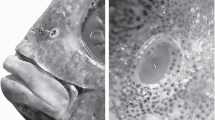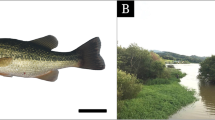Abstract
The morphology and structure of the olfactory organ of Cynoglossus semilaevis Günther are described. The oval olfactory sacs on both sides differ in size and in the number of lamellae, with those on the abocular side having smaller sacs and fewer lamellae than those on the ocular side. On the ocular side, the average ratio of sac length to eye diameter is 2.1 (i.e.>1) with an average of 91 lamellae, while on the abocular side, the values were 1.7 (i.e.>1) and 69, respectively. In addition, the surface morphology varies in different parts of the lamella. The frontal part, near the anterior nostril, is a non-sensory margin with cilia-free epidermal cells. Within this is an internal ciliated sensory area, which is intercalated with ciliated receptor cells and a few ciliated non-sensory cells. Additionally, some dense ciliated non-sensory cells make up a non-sensory area, which also contains cilia-free epidermal cells distributed in patches. In the rear of the olfactory sac near the posterior nostril, the lamellae differ in morphology from those of the frontal olfactory sac but are similar in having few ciliated receptor cells. In other words, the surface of the lamellae in the rear part of the olfactory sac is mainly non-sensory. At present, four types of lamellae (I, II, III and IV) have been recognized in relation to the pattern of the sensory epithelium. In this study, the frontal and rear lamellae resembled types I and IV, respectively, but are referred to as types I′ and IV′ because they are slightly less developed. Data on the ratio of length of lamellae to eye diameter, number of lamellae and the type of surface pattern of the lamellae show that the development of the olfactory system of C. semilaevis facilitates prey capture.
Similar content being viewed by others
References
Bandyopadhyay S K, Datta N C. 1998. Surface ultrastructure of the olfactory rosette of an air-breathing catfish, Heteropneustes fossilis (Bloch). J. Biosis., 23(5): 617–622.
Banerjee T K. 1993. Response of fish skin to certain ambient toxicants. In: Singh, B.R Ed. Advances in Fish Research. Narendra Publishing House, Delhi. vol. 1, p. 185–192.
Bardach J E, Case J. 1965. Capabilities of the modified fins of squirrel hake, Urophycis chuss, and searobins, Prionotus carolinus and P. evolans. Copeia, 2: 194–206.
Fishelson L. 1995. Comparative morphology and cytology of the olfactory organs in moray eels with remarks on their foraging behaviour. Anat. Rec. A, 243(4): 403–412.
Giorgi O, Deiana A M, Salvadori S. 1994. Developmental changes in the content of dopamine in the olfactory bulb of the European eel (Anguilla). Neurosci. Lett., 172(1–2): 35–38.
Hansen A, Zeiske E. 1998. The peripheral olfactory organ of the zebrafish, Danio rerio: an ultrastructural study. Chem. Senses, 23: 39–48.
Hara T J. 1982. Chemoreception in fishes. Elsevier/Academic Press, New York.
Hara J T. 1971. Chemoreception. In: Hoar W S, Randall D J ed. Fish Physiology. Academic Press, New York. vol. 5, p.79–120.
Harvey R. 1996. The olfactory epithelium in plaice (Pleuronectes platessa) and sole (Solea solea), two flatfishes with contrasting feeding behaviour. J. Mar. Biol. Assoc. UK, 76:127–139.
Howell B R. 1997. A re-appraisal of the potential of the sole, Solea solea (L.) for commercial cultivation. Aquaculture, 155: 355–365.
Ichikawa M, Ueda K. 1977. Fine structure of the olfactory epithelium in the goldfish, Carassius auratus. A study of retrograde degeneration. Cell Tissue Res., 183: 445–455.
Kalmijn A J. 1974. The detection of electric fields from inanimate and animate sources other than electric organs. Handbook of Sensory Physiology, 3: 146–199.
Livingston M E. 1987. Morphological and sensory specializations of five New Zealand flatfish species in relation to feeding behaviour. J. Fish Biol., 31: 775–795.
Liu D, Tang W Q, Zhao Y H, Gan Y L, Zhang C G. 2005. Observation on the morphology of the olfactory organ of the eel, Cirrhimuraens Chinensis (Anguilliformes ophichthidae). Acta Zootaxon. Sin., 30(3): 453–460. (in Chinese)
Ma A J, Wang X A. 2007a. Structure of retina and visual characteristics of the tongue sole Cynoglossus semilaevis Günter. Acta Zool. Sin., 53: 354–363. (in Chinese)
Ma X L, Hong W S, Zhang Q Y, Cai M J, Chen S X. 2005. Morphology and structure of olfactory organ in Bostrichthys sinensis. J. Fish Sci. China, 129(5): 526–532. (in Chinese)
Ma A J, Liu X Z, Xu Y J, Liang Y, Zhuang Z M. 2006. Feeding rhythm and growth of the tongue sole, Cynoglossus semilaevis Günter, during its early life stages. Aquacult. Res., 37: 586–593. (in Chinese)
Ma A J, Wang X A, Zhan Z M, Zhang X M, Zhang L J. 2007b. Lateral-line sense organs and dermal surface structure of the tongue sole. Acta Zool. Sin., 53: 1 113–1 120. (in Chinese)
Meng Q W, Su J X, Li W D. 1987. Fish comparative anatomy. Science Publishing Company, Beijing. p. 327–334. (in Chinese)
Müller W. 1981. Comparative and developmental SEM studies on the olfactory epithelia in vertebrates (Biomedical aspects and speculations). Biomed. Res. 2(suppl.): 437–448.
Peter W S, John C. 1997. Chemoreception. In: H. E. David ed. The Physiology of Fishes, 2nd ed. CRC Press, Boca Raton, FL. p. 386–387.
Pfeiffer W. 1964. The morphology of the olfactory organ of Hoplopagrus guentheri Gill 1862. Can. J. Zool., 42: 235–237.
Song T F. 1987. Chemical communication of fish. J. Fish. China, 11(4): 359–371. (in Chinese)
Su J X, Li W D. 1982. A study on the patterns of the olfactory organ of tetraodontiform fishes in China. Acta Zool. Sin., 28(4): 389–398. (in Chinese)
Wang X A, Ma A J, Zhuang Z M, Yu H, Zhang X M, Zhai J M. 2006. Feeding behavior of Cynoglossus semilaevis with different senses. Oceanol. Limnol. Sin., 37(6): 555–560. (in Chinese)
Wang Y L, Zhang Z P, Zheng W Y. 1994. Ultrastructural studies on olfactory epithelia of black sea bream. J. Oceanogr. Taiwan Strait, 13(2): 129–132. (in Chinese)
Wunder W. 1957. Die sinnesorgane der fische. Allgemeine Fischerei-Zeitung, 82: 1–24.
Yamamoto M. 1982. Comparative morphology of the peripheral olfactory organ in teleosts. In: Hara T J ed. Chemoreception in Fishes. Elsevier, Amsterdam. p. 39–59.
Zeng R, Yang C G, 2002. Feeding chemical sense organ of aquatic animals and application of feed attractant in aquatic fodder. China Feed, 23: 15–17. (in Chinese)
Zou G W, Luo X Z, Pan G B, Yang G Q. 2003. Sense utilization of feeding behavior in southern sheatfish (Silurus meriordinalis). J. Dalian Fish Univ. China, 18(4): 236–240. (in Chinese)
Author information
Authors and Affiliations
Corresponding author
Additional information
Supported by Qingdao Natural Science Foundation (No. 09-1-3-10-jch), “Taishan Scholar” Project Special Fund, and the Yellow Sea Fisheries Research Institute Scientific and Research Fund
Rights and permissions
About this article
Cite this article
Ma, A., Wang, X. Functional morphology of the olfactory organ of the tongue sole, Cynoglossus semilaevis . Chin. J. Ocean. Limnol. 28, 209–217 (2010). https://doi.org/10.1007/s00343-010-9006-5
Received:
Accepted:
Published:
Issue Date:
DOI: https://doi.org/10.1007/s00343-010-9006-5




